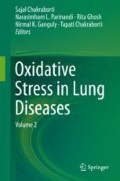Abstract
Cancer-related mortality is a worldwide health issue; among those, lung cancer is devastatingly caused by regular smoking. It is quite surprising that a considerable category of patients with non-small-cell lung cancer (NSCLC) has never had a habit of smoking. In these patients, an elevated level of small drifts or mutations in the epidermal growth factor receptor (EGFR) is observed. The genetic makeup and development of EGFR tyrosine kinase inhibitors (TKIs) are considered as promising drug candidates for the treatment of wild-type NSCLC. The aim of this chapter is to summarize EGFR and its physiological and pathological roles, including the acquired resistance of various generations of TKIs with future perspectives of EGFR-targeted therapeutic approaches.
Access this chapter
Tax calculation will be finalised at checkout
Purchases are for personal use only
References
Uddin MS, Upaganlawar AB (Eds) (2019) Oxidative stress and antioxidant defense: biomedical value in health and diseases. Nova Science Publishers, USA
Jemal A, Tiwari RC, Murray T et al (2004) Cancer statistics, 2004. CA Cancer J Clin 54:8–29
Gupta S (2001) Molecular steps of death receptor and mitochondrial pathways of apoptosis. Life Sci 69(25–26):2957–2964
Gordalize M (2007) Natural products as leads to anticancer drugs. Clin Transl Oncol 9(12):767–776
Ferlay J, Shin HR, Bray F et al (2010) Estimates of worldwide burden of cancer in 2008. Int J Cancer 127:2893–2917
Siegel RL, Miller KD, Jemal A (2015) Cancer statistics, 2015. CA Cancer J Clin 65:5–29
Molina JR, Yang P, Cassivi SD et al (2008) Non-small cell lung cancer: epidemiology, risk factors, treatment, and survivorship. Mayo Clin Proc 83:584–594
Thomas A, Liu SV, Subramaniam DS, Giaccone G (2015) Refining the treatment of NSCLC according to histological and molecular subtypes. Nat Rev Clin Oncol 12(9):511–526
Tovar I, Exposito J, Jaen J et al (2014) Pattern of use of radiotherapy for lung cancer: a descriptive study. BMC Cancer 14:697
Parente Lamelas I, Abal Arca J, Firvida Perez JL (2012) Directed therapies in lung cancer: new hope. Arch Bronconeumol 48:367–371
Chung TW, Tan KT, Chan HL et al (2014) Induction of indoleamine 2,3-dioxygenase (IDO) enzymatic activity contributes to interferon-gamma induced apoptosis and death receptor 5 expression in human non-small cell lung cancer cells. Asian Pac J Cancer Prev 15:7995–8001
Slodkowska J, Rojo MG (2011) Digital pathology in personalized cancer therapy. Folia Histochem Cytobiol 49:570–578
Roskoski R Jr (2014) The ErbB/HER family of protein-tyrosine kinases and cancer. Pharmacol Res 79:34–74
Tebbutt N, Pedersen MW, Johns TG (2013) Targeting the ERBB family in cancer: couples therapy. Nat Rev Cancer 13:663
Elena G, Roberta A et al (2013) Epidermal growth factor receptor tyrosine kinase inhibitors: current status and future perspectives in the development of novel irreversible inhibitors for the treatment of mutant non-small cell lung cancer. Curr Pharm Des 19(5):818–832
Inamura K, Ninomiya H, Ishikawa Y et al (2010) Is the epidermal growth factor receptor status in lung cancers reflected in clinicopathologic features? Arch Pathol Lab Med 134:66–72
Gupta R, Dastane AM, Forozan F et al (2009) Evaluation of EGFR abnormalities in patients with pulmonary adenocarcinoma: the need to test neoplasms with more than one method. Mod Pathol 22:128–133
Shigematsu H, Gazdar AF (2006) Somatic mutations of epidermal growth factor receptor signaling pathway in lung cancers. Int J Cancer 118:257–262
Ladanyi M, Pao W (2008) Lung adenocarcinoma: guiding EGFR-targeted therapy and beyond. Mod Pathol 21:S16–S22
Massarelli E, Varella-Garcia M, Tang X et al (2007) KRAS mutation is an important predictor of resistance to therapy with epidermal growth factor receptor tyrosine kinase inhibitors in non-small-cell lung cancer. Clin Cancer Res 13:2890–2896
Lax I, Burgess WH et al (1988) Localization of a major receptor-binding domain for epidermal growth factor by affinity labeling. Mol Cell Biol 8(4):1831–1834
Dokala A, Thakur SS (2017) Extracellular region of epidermal growth factor receptor: a potential target for anti-EGFR drug discovery. Oncogene 36:2337–2344
Chen L, Fu W et al (2018) Recent progress of small-molecule epidermal growth factor receptor (EGFR) inhibitors against C797S resistance in non-small-cell lung cancer. J Med Chem 61(10):4290–4300
Author information
Authors and Affiliations
Editor information
Editors and Affiliations
Rights and permissions
Copyright information
© 2020 Springer Nature Singapore Pte Ltd.
About this chapter
Cite this chapter
Parambi, D.G.T., Noorulla, K.M., Sahab Uddin, M., Mathew, B. (2020). Epidermal Growth Factor Receptor: Promising Targets for Non-Small-Cell Lung Cancer. In: Chakraborti, S., Parinandi, N., Ghosh, R., Ganguly, N., Chakraborti, T. (eds) Oxidative Stress in Lung Diseases. Springer, Singapore. https://doi.org/10.1007/978-981-32-9366-3_21
Download citation
DOI: https://doi.org/10.1007/978-981-32-9366-3_21
Published:
Publisher Name: Springer, Singapore
Print ISBN: 978-981-32-9365-6
Online ISBN: 978-981-32-9366-3
eBook Packages: Biomedical and Life SciencesBiomedical and Life Sciences (R0)

